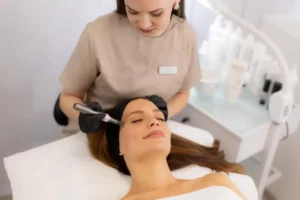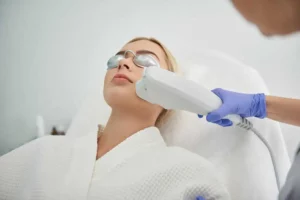
No matter their age or gender, millions of individuals throughout the world worry about hair loss. With advancements in medical science, hair restoration techniques have significantly evolved, like hair transplant and grafting, offering more effective and natural-looking solutions than ever before. This guide dives into these methods, shedding light on what you can expect from hair restoration services in the area.
Understanding Hair Restoration
Hair restoration encompasses various surgical and non-surgical techniques designed to restore or improve hair density and appearance on the scalp and other areas affected by hair loss. Among these methods, hair transplant and hair grafting stand out as two of the most influential and widely adopted techniques.
Hair Restoration Treatments
Hair Transplant Surgery
In hair transplant surgery, there are two primary strategies used:
- Follicular Unit Transplantation (FUT): This method involves removing a strip of skin from the back or side of the scalp, where hair is more resistant to balding. After that, the strip is split into individual follicular units, which are subsequently applied to the areas that are balding.
- Follicular Unit Extraction (FUE): Individual hair follicles are taken straight out of the scalp and placed into balding or thinning areas in a process known as FUE. With less scarring and less invasiveness than FUT, this procedure allows for a quicker recovery.
Hair Graft
Hair grafting is an essential component of hair transplant procedures, referring to the process of implanting the harvested hair follicles into the recipient areas. The density that is sought and the amount of hair loss determine how many hair transplants are required.
A hair graft can include one to four hair follicles. Hair grafts are positioned to resemble natural hair growth patterns thanks to sophisticated technologies and detailed processes, producing undetectable and visually beautiful results.
Platelet-Rich Plasma (PRP) Therapy
As part of PRP therapy, the patient’s blood is extracted, treated to concentrate the platelets, and then injected into the scalp. Platelet-derived formation factors can help hair follicles grow and may be a helpful treatment for androgenetic alopecia (male or female pattern baldness).
Scalp Micropigmentation (SMP)
Microneedles are used in SMP, a non-surgical procedure, to apply pigment to the scalp. It gives the appearance of microscopic hair follicles, which aids in giving the impression of a shaved or larger head of hair. For people who want to improve their density and appearance following a transplant or who are not eligible for hair transplant surgery, SMP is a great choice.
Low-Level Laser Therapy (LT)
Lasers or LEDs, are used in LT, a type of light therapy, to increase cellular activity and encourage the creation of new hair. It’s a non-invasive treatment that can be used alone or in conjunction with other therapies. LLLT devices come in various forms, including combs, caps, and helmets, making them a convenient option for home use as well.
Medications
Beyond over-the-counter options like Minoxidil, there are prescription medications such as Finasteride (for men) and Spironolactone (for women) that healthcare professionals can prescribe to treat hair loss. These medications work by addressing hormonal factors that contribute to hair loss.
Hair Cloning and Cell Therapy (Emerging)
Hair cloning and cell therapy represent the frontier of hair restoration research. These methods involve harvesting cells from the hair follicle, multiplying them in a lab, and then injecting them back into the scalp to stimulate new hair growth. While not yet widely available, they hold promise for future treatment options.
Safety and Considerations
When considering Hair Restoration treatments, safety and careful consideration are paramount to ensuring a successful outcome and minimizing potential risks. Here are key safety aspects and considerations to keep in mind:
- Choose a Qualified Specialist: Select a board-certified dermatologist or plastic surgeon with extensive experience in hair restoration techniques. Their experience can guarantee the finest outcomes and drastically lower the chance of difficulties.
- Understand the Procedure: Familiarize yourself with the details of the procedure you’re considering, whether it’s a surgical option like FUT or FUE or a non-surgical treatment like PRP therapy. Knowing what to expect can help you make an informed decision.
- Assess Risks and Complications: Although modern hair restoration procedures are generally safe, all medical treatments carry some level of risk. Discuss potential risks and complications with your specialist, such as infection, scarring, and the possibility of unsatisfactory results.
- Post-Treatment Care: Follow your specialist’s instructions for post-treatment care diligently to minimize the risk of complications and promote healing. This may include guidelines on washing your hair, avoiding certain activities, and taking prescribed medications.
- Realistic Expectations: Set reasonable expectations for the result. Your appearance and self-confidence can be significantly enhanced by hair restoration. Still, it’s crucial to realize that results vary depending on personal characteristics, including hair density, texture, and degree of hair loss.
- Consider Long-Term Maintenance: Be aware that additional treatments may be necessary in the future, as hair loss can continue with age. Discuss a long-term plan with your specialist to maintain your results.
- Cost and Financial Consideration: Hair restoration procedures can be an investment. Consider the financial aspects, including the initial cost of the procedure, the potential need for follow-up treatments, and any associated maintenance costs.
Safety should always be your top priority when considering any medical procedure. By choosing a reputable specialist, understanding the process and risks, and following post-procedure care instructions, you can maximize the benefits of Hair Restoration treatments while minimizing potential risks.
Choosing the Right Procedure in Rockwall, TX
Seeking advice from a licensed and knowledgeable hair restoration practitioner is essential when thinking about hair restoration in Rockwall, Texas. The professional will assess your hair loss pattern, go over your expectations, and, after considering your particular circumstances, offer the best method during the consultation. To guarantee the best outcomes, variables such as the degree of hair loss, hair density at the donor site, lifestyle, and general health are taken into account.
In fact, Revive Aesthetics & Healthcare is recognized as one of the industry’s leading providers of hair restoration services. From the initial consultation to the point of recovery, each patient will receive individualized, natural-looking results from their team of highly qualified specialists, guaranteeing a smooth and enjoyable experience. With a commitment to the latest advancements in hair restoration technology, Revive Aesthetics & Healthcare sets the standard for excellence in patient care and outcomes.
Conclusion
Hair restoration techniques provide effective solutions for those battling hair loss, restoring confidence and appearance. Revive Aesthetics & Healthcare in Rockwall, TX, offers a cutting-edge, non-surgical Hair Restoration technique using PRP (Platelet-Rich Plasma) through microneedling or injections to naturally stimulate hair growth and improve hair density in areas experiencing thinning or loss. Unlock the secret to fuller, natural-looking hair with cutting-edge hair restoration treatments, and reclaim the confidence that comes with a revitalized, youthful appearance.







